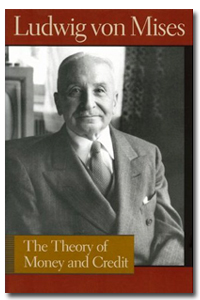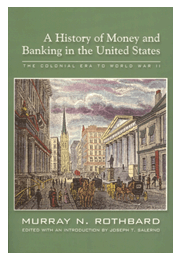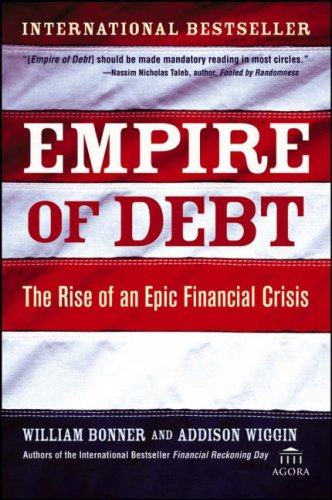
Mises: The Theory of Money and Credit
By Ludwig von Mises
Signalman Publishing 2009
300 pages.
In The Decline of the West, Oswald Spengler had much to say about the political aspects of money. “Money does not pass, politically, from one hand to the other. It does not turn itself into cards and wine. It is turned into force, and its quantity determines the intensity of its working influence. Through money, democracy becomes its own destroyer, after money has destroyed intellect.”
One suspects that Ludwig von Mises would agree with Spengler’s criticism of money when used as a political force instead of as a medium of exchange. Von Mises’ book, written in German, was originally published in 1912. While Spengler’s book was published in 1918, also in German. Spengler was a historian; von Mises was an economist. Which means von Mises’ view of money was theoretical and practical, not abstract as was Spengler’s.
Von Mises’ book is divided into four parts: The Nature of Money; The Value of Money; Money and Banking; Monetary Reconstruction. The latter section – the fourth part – was tacked on in 1952.
The first two parts of the book consider money from a philosophical/theoretical standpoint, whereas parts three and four are more utilitarian.
Part One examines the nature of money, including its functions, measuring its value, various types of money, money in the context of government, money as an economic good, and the enemies of money. The material is presented in a highly technical manner, which means it is not an easy read. However, it is well-worth the effort, because the information imparted is indispensable, laying a foundation for the second half of the book.
One of the most interesting chapters included in Part One is ‘The Enemies of Money.’ Von Mises names two enemies of money: socialism, and money cranks. Under socialism, “production and distribution are to be systematically regulated by a central body.” According to von Mises such a system will not work, for it is self-contradicting, involving “a reduction in the purchasing power of money.” Money cranks are people who want to get rid of money altogether. These people believe money is the root of all evil. Von Mises refers to these people as “confused” and states that “it is hardly worthwhile to devote even a moment to such fantastic suggestions.”
Part Two speaks of the value of money. Von Mises starts off by saying, “The central element in the economic problem of money is the objective exchange value of money, popularly called its purchasing power.” This portion of the book is a technical blueprint on the hows and whys of monetary valuation. And it proves arduous for readers who do not have a basic understanding of theoretical valuation. For von Mises thoroughly dissects the subject from every angle.
Part Three, which examines money and banking, is where things get a lot more interesting. Primarily, because the material can be applied to the present economic crisis in the U.S. Von Mises discusses the limits of credit extension by banks, stating that banks have never gone as far as they could in this area. By reducing the rate of interest on loans banks can postpone a market collapse; but eventually a breaking point will be attained. At that point, according to von Mises, implosion occurs. And the attending circumstances are intensified and prolonged.
To all intents and purposes, von Mises appears to be describing the current ‘easy money’ environment in America. Such prescience is scary. Von Mises holds that interest rates should adjust naturally to market forces. They should not be artificially depressed by outside interference.
Von Mises ends Part Three by talking about banking freedom, gold and the gold standard. He states that when a central bank dictates the interest rate, as “superficial critics” believe is necessary and proper, “nothing could be more mistaken.”
Part Four is where von Mises reflects on the principles of sound money as compared to the present currency systems prevalent throughout most of the world. “Thus the sound-money principle has two aspects. It is affirmative in approving the market’s choice of a commonly used medium of exchange. It is negative in obstructing the government’s propensity to meddle with the currency system.” A few sentences later, he states bluntly, “Sound money mean[s] a metallic standard.”
Von Mises explains that governments got rid of the gold standard so they could introduce the idea of inflation into the system. Why? Because inflation allows the shift of wealth and income from some groups to others. Therefore, fiat money was substituted for sound money. His comment on this pinch hitter policy is succinct and to the point: “The most remarkable thing about this allegedly new monetary policy, however, is its complete failure.”
A return to a gold standard is advocated by von Mises. He notes, however, that such a reform infers a “radical change in economic philosophy.” There are two choices available, writes von Mises. “The utopia of a market economy, not paralyzed by government sabotage on the one hand, and the utopia of totalitarian all-round planning on the other hand.” His concludes that if the first choice – a free market economy – is selected, it “implies the decision in favor of the gold standard.”
Many knowledgeable individuals believe this is the best book ever written on money and credit. And they are probably right, for it has no peer, especially as concerns the Austrian school of economics. The book does, though, have two minor flaws, both of which concern readability. First, the book demands a certain degree of economic sophistication. In other words, it is not for economic dilettantes. Rather it is intended for intelligent readers, who understand economic theory. Second, the translation is bent with age. A more modern translation from the German to English would benefit readers.
![]() On the Read-O-Meter, which ranges from 1 star (flawed) to 5 stars (perfect), Mises: The Theory of Money and Credit is valued at 5 stars for content and 4 stars for readability.
On the Read-O-Meter, which ranges from 1 star (flawed) to 5 stars (perfect), Mises: The Theory of Money and Credit is valued at 5 stars for content and 4 stars for readability.


